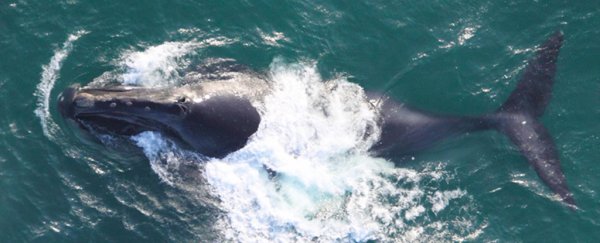There aren't many North Pacific right whales left, with vague estimates in the low hundreds. Those last few populations aren't known for waxing lyrical either, so when scientists heard a population recently break out into song, they had to go see them live in concert.
For the first time, National Oceanic and Atmospheric Administration (NOAA) researchers have records of vocalisations made by a tiny group of eastern North Pacific right whales (Eubalaena japonica) in the Bering Sea.
Unlike many other cetaceans, right whales tend to be rather shy when it comes to songs, sticking instead to individual calls between members of a pod.
When researchers picked up interesting noises through a series of acoustic recorders scattered across the Bering Sea a number of years ago, they understandably got excited.
"During a summer field survey in 2010, we started hearing a weird pattern of sounds," says marine mammal scientist Jessica Crance from NOAA's Alaska Fisheries Science Center.
"We thought it might be a right whale, but we didn't get visual confirmation. So we started going back through our long-term data from moored acoustic recorders and saw these repeating patterns of gunshot calls."
While right whales have been known to make these loud cracking sounds before, the repeated vocalisations had the hallmarks of a song, remaining remarkably consistent over the years and across different locations.
They're not exactly what you'd call operatic, but a song's a song, and to the researchers it provides an opportunity to eavesdrop on right whale culture.
The booms and grunts could be categorised into four pattern types comprising of different gunshot phrases, which you can hear below and also find here and here.
Hearing the sounds was one thing. But to be absolutely certain these noises were made by the endangered whales, the team needed to meet the band personally.
That finally happened a couple of years ago, when songs were detected through directional sonobuoys in the southeastern Bering Sea on three separate occasions.
"We heard these same songs during a summer survey in 2017, and were able to localise the songs to male right whales," says Crance.
The team quickly associated each event with a pair swimming nearby, with one or even both beat-boxing as the boat approached and continuing after the researchers departed.
It's not known what the song was communicating, as there was no obvious behaviour the researchers could link it to. The only sex they could identify was male, though some of the undescribed vocalists might have been female.
"We can now definitively say these are right whales, which is so exciting because this hasn't been heard yet in any other right whale population," says Crance.
Of this particular eastern population of North Pacific right whale, there's maybe 30 individuals left. That's it. Their slow moving nature and macabre characteristic of floating after they die has made them the 'right' whale for whaling.
With extinction looming on the horizon, the researchers are keeping such a close eye on them. Interestingly, it could be their tiny population that's inspiring the males to break into chorus.
"Lone male right whales tend to gunshot more frequently than females," says Crance.
"Perhaps the 2:1 male ratio in the North Pacific has led to our males singing to attract females. But we may never be able to test that or know for sure."
The team now plans on going back over years of acoustic data collected throughout that corner of the ocean, to see if they can spot tell-tale changes in the patterns that might indicate how the songs evolved.
With such a small population, the fate of these right whales isn't certain. Though they've been universally protected from official whaling programs since the 1930s, they still face unintended threats from other human activities, such as fishing nets and climate change.
We can only hope researchers might find out what they can before these few samples are filed into history's back catalogue of memorable whale songs.
This research was published in The Journal of the Acoustical Society of America.
